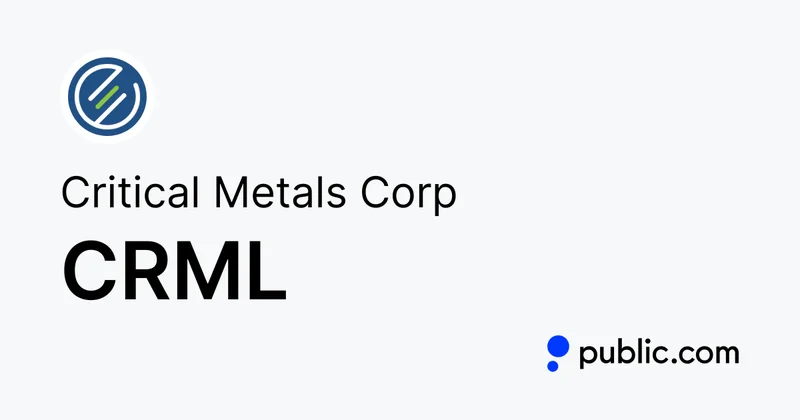Of course. Here is the feature article, written from the persona of Dr. Aris Thorne.
*
You might have seen the headlines on Monday. A company called Critical Metals Corp, ticker CRML, saw its stock price explode, jumping over 80% in a flash. The immediate cause? A $35 million investment from a serious institutional player to fund their massive rare earth project in Greenland.
It’s easy to dismiss this as just another flicker on the chaotic screen of Wall Street—a speculative bet, a momentary surge of "hype over fundamentals," as one outlet put it. But I’m telling you, if you see this as just another stock story, you are missing the forest for the trees. You’re missing the plot entirely.
What we are witnessing isn't just a financial transaction. It's a signal. It’s one of the first tangible, dirt-under-the-fingernails steps toward building the physical bedrock of the next technological age. For years, we’ve talked about AI, clean energy, and quantum computing as if they were ethereal concepts born in the cloud. They’re not. They are born from the earth, and the fight to secure the elements that give them life is just beginning.
The Raw Code of Reality
Let’s take a step back. When we talk about "rare earth elements," what are we really talking about? These aren't just fancy-sounding materials; they are the secret ingredients, the essential vitamins, for nearly every piece of advanced technology we rely on.
Think of it this way: your smartphone, the electric vehicle you’re dreaming of, the MRI machine that saves lives, the guidance systems in our most advanced defense technology—they all depend on tiny amounts of elements like neodymium, terbium, and dysprosium. These are the materials that create the powerful, lightweight magnets and sophisticated electronics that make our modern world possible. They are, in essence, the hardware that runs the software of our lives.

This is why the Tanbreez project in Greenland is so breathtakingly important. We're talking about one of the largest known rare earth deposits on the planet, a staggering 4.7 billion metric tons of material nestled in a deep-water fjord with year-round shipping access to the North Atlantic. Imagine standing on the edge of that fjord, the cold Greenland air on your face, looking out at the water that leads directly to Europe and North America. That isn't just a potential mine; it's a future artery, ready to pump the lifeblood of 21st-century industry into the Western world. When I first read about the sheer scale of this deposit, I honestly just felt a wave of relief wash over me. This is the kind of breakthrough that reminds me why I got into this field in the first place. It’s real. It's tangible.
The new $35 million in funding is the fuel, but the engine was already being primed. Reports have been swirling for months about the U.S. government, specifically the Trump administration, looking to convert a $50 million grant application from the company into a direct equity stake, prompting some to ask The Trump Admin Wants a Stake in Critical Metals Corp. Does That Make CRML Stock a Buy Here? This is the government moving beyond simple grants and loans—in simpler terms, it means they want to be a part-owner, a true partner in the mission. Are we finally waking up to the stakes of this game?
From Speculation to Foundation
Now, I know what the skeptics say. I read the reports, like those asking Why Is Critical Metals Stock (CRML) Up Over 80% Today?, calling CRML a "speculative bet" with "thin financials" and no revenue. And from a traditional, quarter-to-quarter accounting perspective, they’re not wrong. But that perspective is tragically shortsighted.
Valuing a company like Critical Metals based on its current revenue is like valuing the Apollo program in 1962 based on how many moon rocks it had sold. It completely misses the point. This isn't an investment in a product; it's an investment in a capability. It’s a foundational play, much like the government’s investment in the interstate highway system in the 1950s. Did anyone know exactly which businesses would thrive because of it? No. But they knew it would unlock a new era of commerce and connection for the entire nation. That’s what we’re looking at here.
The convergence of this new private institutional money and the sustained interest from the U.S. government is the real story—it’s the kind of public-private alignment that signals a true paradigm shift is underway and it’s happening faster than anyone seems to realize. This isn’t just about one company anymore. It’s about building a resilient, independent supply chain for the very materials that will power our future. What happens when our access to these elements is no longer a geopolitical bargaining chip? What new wave of innovation is unleashed when our brightest minds know they have a secure, reliable source of the planet's most technologically potent materials?
Of course, with this great opportunity comes an immense responsibility. The mission can't be just to extract these resources; it has to be about setting a new standard for how it's done. Mining in a pristine environment like Greenland demands the utmost care, a partnership with the local communities, and a commitment to sustainability that reflects the clean energy future these materials will help build. We have to be better.
This is more than a stock ticker. It’s a blueprint for the future's infrastructure. It’s messy, it’s expensive, and it’s fraught with risk. But it’s absolutely necessary. We are finally moving from dreaming about tomorrow to actually building the machine that will take us there.
Building the Engine of What's Next
Forget the daily stock chart for a moment and see the bigger picture. The code for our future may be written in Python and C++, but the machines that run it are forged from the elements of the earth. For too long, we’ve ignored the hardware side of the equation. This—this messy, ambitious, speculative scramble for the planet's most vital minerals—is the course correction. It’s the moment we stopped just designing the future and started physically building its engine. And it’s one of the most exciting developments I’ve seen in years.









